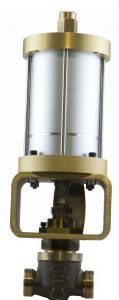Discover the Differences Between Actuators
Choosing an Actuator—Where to Start
What makes a valve a valve is its ability to control flow. It stops it, allows it, or holds it somewhere in between.
The mechanism that makes this happen is the actuator. Simply put, the actuator opens and closes the valve.
But there’s a bit more to it than just that…
- First, it has to be able to move the valve closure member (ball, disc, or plug). It must have enough torque (for quarter-turn) or thrust (for linear) to be able to move it regardless of conditions.
- The actuator must hold the valve open or closed (or at a specific position between the two) against the forces trying to move it. This includes holding up to dynamic torque conditions where necessary.
- It needs to have a system failure mode or position. Depending on the circumstances, failure may require the valve remain open, closed, or again at a designated position somewhere in between.
- For partial-turn valves, the actuator must have the ability to rotate it to the degree required (90°, 180°, etc.). When rotation greater than 180° is needed, electric actuators are the more popular choice.
- It has to be able to operate at the required duty cycle and speed. When considering an electric actuator, special attention should be paid to the maximum speed required.
Types of Actuators
Here’s a quick rundown of the basic types of actuators based on how they are powered:
Manual actuators require someone to physically move them by turning a hand wheel or switching a gear or a lever. The wheel can be attached directly to the valve stem or will sometimes use gears to make turning the wheel easier. Manual actuators are the simplest and least expensive option. There are, however, many instances where they are either not practical or not safe. They may be too large to be able to turn by hand or they might be inaccessible due to their being in hazardous or hard-‐to-‐reach locations.
Pneumatic actuators use air pressure (compressed air) to move a diaphragm or piston which in turn moves the valve stem. They are useful when modulating or throttling the fluid is necessary. Pneumatic actuators can be used for linear or quarter-‐turn valves.
Hydraulic actuators use fluid pressure instead of air pressure. Like pneumatic actuators, they are used for linear or quarter-‐turn valves. The addition of a spring makes them a good choice where a fail-safe mechanism is needed. Unlike pneumatic actuators, they can be used on one or both sides of a piston when valves need to be moved both ways.
When more force is needed, hydraulic actuators have a huge advantage over their pneumatic cousins…they can produce 25 times the force of pneumatic valves.
Electric actuators are powered by an electric motor and are connected to the valve stem by way of gears. Hand wheels or backup power can be added in the event of power failure.
Solenoid actuators use a magnetic slug. The slug (attached to the valve stem) is drawn to an electromagnetic coil in the actuator. They can also be positioned manually.
Self-‐actuated valves are those that are moved into position by the movement of the fluid in the system. Safety, relief, and check valves are self-‐actuated.
Comparison of Characteristics—Pneumatic vs. Electric
Two of the most commonly used types of automated actuators are pneumatic (like CPV’s FloMaster of pneumatic control valves) and electric. Some of the considerations when making a choice between the two are as follows:
Power Supply
The first step in deciding whether to use a pneumatic or electric actuator is to look at the power source.
Pneumatic actuators need to have an air pressure supply of 40 to 120 psi…CPV FloMaster Valves need less than 100 psi.
Electric actuators require a 115 VAC power supply. In some cases, AC or DC motors of different sizes may be used.
Temperature
Standard pneumatic actuators can operate in ‐4 to 174°F. That can be stretched to ‐40 to 250°F by simply using the right seals, bearings, and grease. CPV FloMaster Valves have a temperature range of 20 to 225°F. Note that cold temperatures bring the risk of freezing condensation which can block air supply lines leading to failure.
Electric actuators operate between -40 to 150°F. Care should be taken to shield electric actuators from the elements if they’re used outdoors. It’s possible for condensation to form due to temperature fluctuations and moisture. A heater should be used wherever there’s risk of condensation to help alleviate this problem.
Hazardous areas
Electric actuators may be needed in a hazardous area. When used in hazardous areas the electric actuator must have the proper enclosure for containing an internal explosion without causing external damage following the National Electrical Manufacturers Association (NEMA) Type 7 guidelines for electric devices. Many manufacturers have a version of their products that conform to these guidelines.
Pneumatic actuators, on the other hand, can be used in hazardous areas without concern for fire or explosion risk. They are the safer option. Using electric controls with pneumatic actuators is a cost-effective way of dealing with such situations.
Spring Return
Required in most industries, the spring return actuator returns the valve to a safe position in the event that it doesn’t receive a signal due to power loss or other problem. It’s a cost-effective solution with pneumatic actuators. In the case where springs won’t work due to size or weight of the actuator, an accumulator tank can be used to store air pressure.
Electric actuators can be equipped with a battery backup in lieu of a spring return, which isn’t as available.
Duty Cycle
The harder pneumatic actuators work, the better they work. They have a 100 percent duty cycle which means they can run constantly.
Most electric actuators have a 25 percent duty cycle…for every 1 minute of cycle time, they need 3 minutes of rest. They will overheat if they are run continuously. This isn’t usually a concern since most on-‐off automated valves are idle about 95 percent of the time. If it’s necessary, electric actuators can be upgraded to as much as 100 percent by using capacitors and optional motors.
Speed Control
Controlling the speed of pneumatic actuators is not difficult, assuming the supply and exhaust lines are correctly sized. Fitting it with a needle valve at the air pilot exhaust port is the simplest way to control speed.
Electric actuators, on the other hand, can be adjusted to operate more slowly. But overall, speed control in electric actuators is much more challenging. The speed is based on the power of the motor.
Sizing
Whether pneumatic or electric, selecting the right size actuator is a complicated process. It’s based on the required torque, the minimum and maximum supply pressure, the type of actuator, the failure mode requirements, and the characteristics of the valve and media. Using an undersized or oversized actuator can lead to failure. Always consult a trained expert for sizing actuators.
It’s always important to have the right tools for the right job…that applies to valves, fittings, and actuators just as much as it does to drill bits and Allen wrenches. Our trained valve experts are happy to help with any questions you might have.

